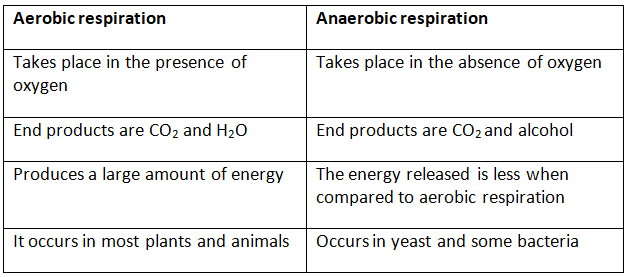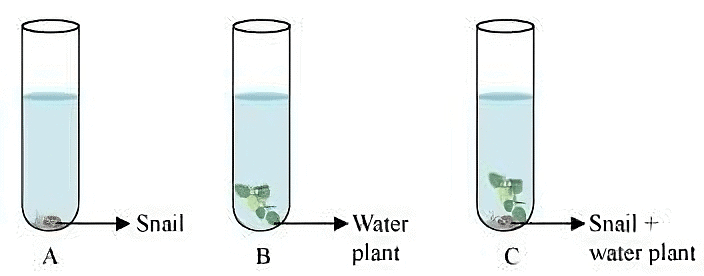NCERT Solutions for Class 7 Science - Respiration in Organisms
Q1. Why does an athlete breathe faster and deeper than usual after finishing the race?
Ans: During the run, the demand of energy is high but the supply of oxygen to produce energy is limited. Therefore, anaerobic respiration takes places in the muscle cells to fulfill the demand of energy. After finishing the race, an athlete breathes faster and deeper than usual so that more oxygen is supplied to the cells.

Q2. List the similarities and differences between aerobic and anaerobic respiration.
Ans: The similarities and differences between aerobic and anaerobic respiration are as follows:
Similarities:
- Food Particles are broken down to release energy.
- Carbon dioxide is released into the atmosphere.
- Both supply by-products
Differences: 
Q3. Why do we often sneeze when we inhale a lot of dust-laden air?
Ans: We often sneeze when we inhale a lot of dust-laden air to expel out these foreign particles. These particles get past the hair in the nasal cavity and irritate the lining of the cavity which results in sneezing.
Q4. Take three test-tubes. Fill each of them with water. Label them A, B and C. Keep a snail in test-tube A, a water plant in test-tube B and in C, keep snail and plant both. Which test-tube would have the highest concentration of CO2?
Ans: 
- The test tube A will have the highest concentration of carbon dioxide. The carbon dioxide comes because of respiration by the snail.
- In test tubes B and C a part of the carbon dioxide is utilized by the plant for photosynthesis and hence there is less concentration of carbon dioxide.
Q5. Tick the correct answer:
 Cockroach Respiration
Cockroach Respiration
(a) In cockroaches, air enters the body through
(i) lungs
(ii) gills
(iii) spiracles
(iv) skin
Ans: (iii) Spiracles
Explanation: Spiracles are small openings or holes, typically found in insects, spiders, and some fish, that allow for the exchange of gases, such as oxygen and carbon dioxide, between the organism's respiratory system and the external environment.
(b) During heavy exercise, we get cramps in the legs due to the accumulation of
(i) carbon dioxide
(ii) lactic acid
(iii) alcohol
(iv) water
Ans: (ii) Lactic acid
Explanation: Lactic acid, also known as lactate, is an organic acid produced by various biological processes, including fermentation and muscle metabolism. In the human body,
(c) Normal range of breathing rate per minute in an average adult person at rest is:
(i) 9–12
(ii) 15–18
(iii) 21–24
(iv) 30–33
Ans: (ii) 15 – 18
Explanation: The normal range of breathing rate per minute in an average adult, for a person at rest, is 12 – 20 breaths per minute. Any person having a breathing rate under 12 or over 25 is considered to be breathing abnormally.
(d) During exhalation, the ribs
(i) move outwards
(ii) move downwards
(iii) move upwards
(iv) do not move at all
Ans. (ii) Move downwards
Explanation:
 Exhalation ProcessExhalation, also known as expiration, is the process of expelling air from the lungs and releasing carbon dioxide into the atmosphere.
Exhalation ProcessExhalation, also known as expiration, is the process of expelling air from the lungs and releasing carbon dioxide into the atmosphere.
Q6. Match the items in Column I with those in Column II:
Column I | Column II |
Yeast | Earthworm |
Diaphragm | Gills |
Skin | Alcohol |
Leaves | Chest cavity |
Fish | Stomata |
Frog | Lungs and skin |
Ans:
Column 1 | Column II |
Yeast | Alcohol |
Diaphragm | Chest cavity |
Skin | Earthworm |
Leaves | Stomata |
Fish | Gills |
Frog | Lungs and skin |
Q7. Mark ‘T’ if the statement is true and ‘F’ if it is false:
(i) During heavy exercise the breathing rate of a person slows down.
Ans: False
(ii) Plants carry out photosynthesis only during the day and respiration only at night.
Ans: False
(iii) Frogs breathe through their skins as well as their lungs.
Ans: True
(iv) The fishes have lungs for respiration.
Ans: False
(v) The size of the chest cavity increases during inhalation.
Ans: True
Q8. Given below is a square of letters in which are hidden different words related to respiration in organisms. These words may be present in any direction— upwards, downwards, or along the diagonals. Find the words for your respiratory system. Clues about those words are given below the square. (i) The air tubes of insects
(i) The air tubes of insects
(ii) Skeletal structures surrounding the chest cavity
(iii) Muscular floor of the chest cavity
(iv) Tiny pores on the surface of a leaf
(v) Small openings on the sides of the body of an insect
(vi) The respiratory organs of human beings
(vii) The openings through which we inhale
(viii) An anaerobic organism
(ix) An organism with a tracheal system
Ans:

(i) Trachea
(ii) Ribs
(iii) Diaphragm
(iv) Stomata
(v) Spiracles
(vi) Lungs
(vii) Nostrils
(viii) Yeast
(ix) Ant
Q9. The mountaineers carry oxygen with them because:
(a) At an altitude of more than 5 km there is no air
(b) The amount of air available to a person is less than that available on the ground.
(c) The temperature of air is higher than that on the ground.
(d) The pressure of air is higher than that on the ground.
Ans: (b) The amount of air available to a person is less than that available on the ground.
Explanation: The mountaineers carry oxygen with them because (b) The amount of air available to a person is less than that available on the ground.
|
112 videos|286 docs|28 tests
|
FAQs on NCERT Solutions for Class 7 Science - Respiration in Organisms
| 1. What is respiration in organisms? |  |
| 2. What are the types of respiration? |  |
| 3. What is the importance of respiration in organisms? |  |
| 4. What is the difference between breathing and respiration? |  |
| 5. How does the respiratory system work in humans? |  |

















